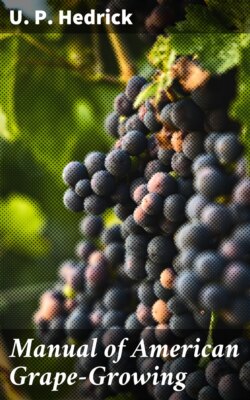Читать книгу Manual of American Grape-Growing - U. P. Hedrick - Страница 72
На сайте Литреса книга снята с продажи.
CHAPTER IV
ОглавлениеTable of Contents
STOCKS AND RESISTANT VINES
Phylloxera, a tiny root-louse, made its appearance in France in 1861 and began multiplying with a fury unparalleled in the insect world. By 1874, the pest had become so widespread in Europe that it threatened the very existence of the great vineyard industry of that continent. All attempts to bring the pest under control failed, although the French government offered a reward of 300,000 francs for a satisfactory remedy. Numerous methods of treating the soil to check the ravages of the insect were tried, also, but none was efficacious. Finally, it dawned on European vineyardists that phylloxera is not a scourge in America, its habitat, and that European vineyards might be saved by grafting Vinifera vines on the roots of immune American grapes. At once the reconstruction of vineyards in Europe was begun by grafting the grapes on phylloxera-resistant roots. Meanwhile, consternation spread to California when it was discovered that phylloxera was running riot in some of the vineyards of the Pacific slope; however, with the knowledge derived from viticulturists in Europe, they too began reconstructing vineyards on immune roots, without the same success as the Europeans, it is true, but with such measure of success that it soon became the approved method of growing grapes in this great region.
Through the use of resistant stocks, phylloxera is now defied in Vinifera regions. Millions of American stocks are annually struck at home, in Europe and wherever Vinifera grapes are grown, to be top-worked with varieties susceptible to phylloxera. Seldom has mastery over a pest been so complete; but, to triumph over the tiny insect, the industry has had to be revolutionized. Resistant stocks, in their turn, brought innumerable new problems, many of which are still unsolved. Investigations and experiences in rehabilitating vineyards have been carried on for forty years, the results set forth in books and bulletins and yet there are many problems to be solved. The grape-grower in regions infested with phylloxera is always under the necessity of taking advantage of the latest demonstration of practices in the use of resistant stocks. These practices are best studied in the experiments of state experiment stations and the United States Department of Agriculture, and in the vineyards of leading grape-growers, since even those most needing elucidation can be but briefly discussed in the following paragraphs.
The wild vines of a species are always seedlings and are hence exceedingly variable. The first vineyards of resistant stocks were vines grafted on stocks of wild vines, and the results were very unsatisfactory; for, naturally, there was divergence in many characters and especially in the vigor of the vines. Also, there was difficulty in grafting, since some wild vines are stout and others slender; some bear grafts well, while others do not. It soon became apparent that to succeed, varieties must be selected from the different species for vineyard work. The great task of the experimenter and grape-grower, therefore, has been to select varieties of the several species sufficiently resistant, vigorous and otherwise possessed of characters fitting them to become good stocks. Out of vast numbers tested, a few are now generally recognized as best for the several groups of Vinifera grapes and the several distinct regions in which these grapes are grown.
